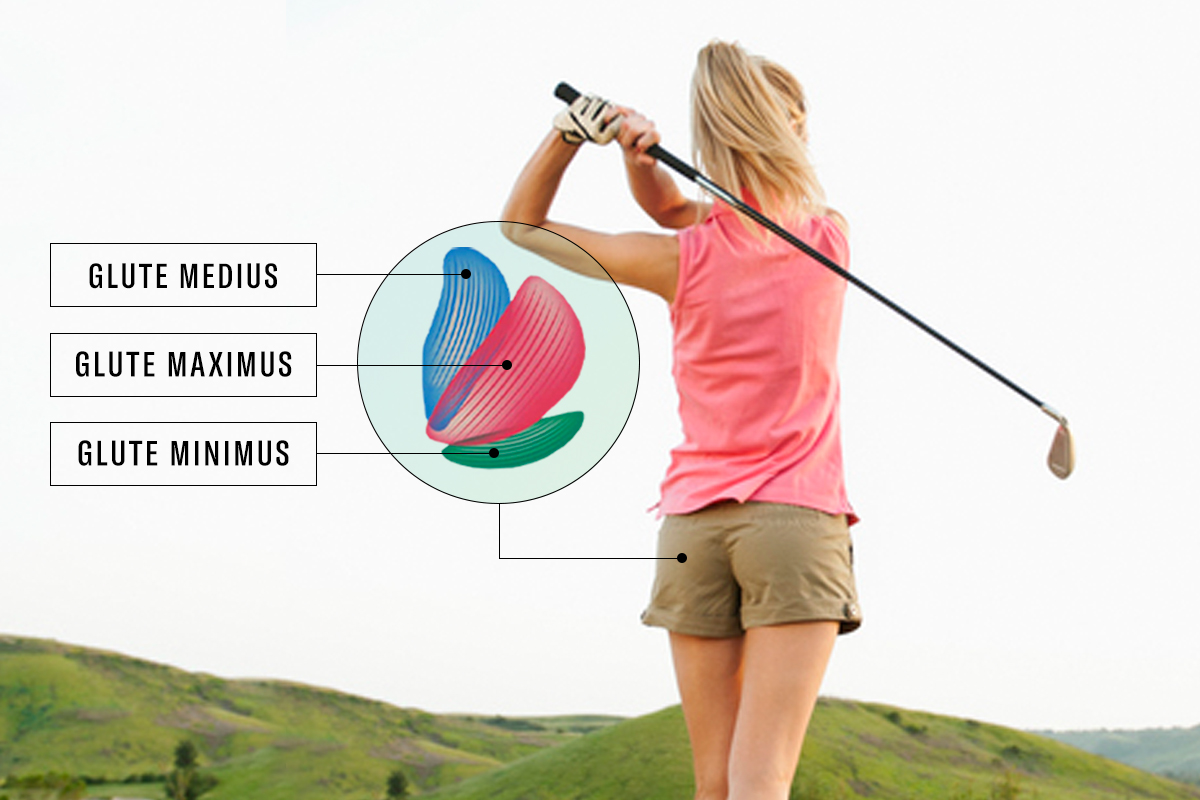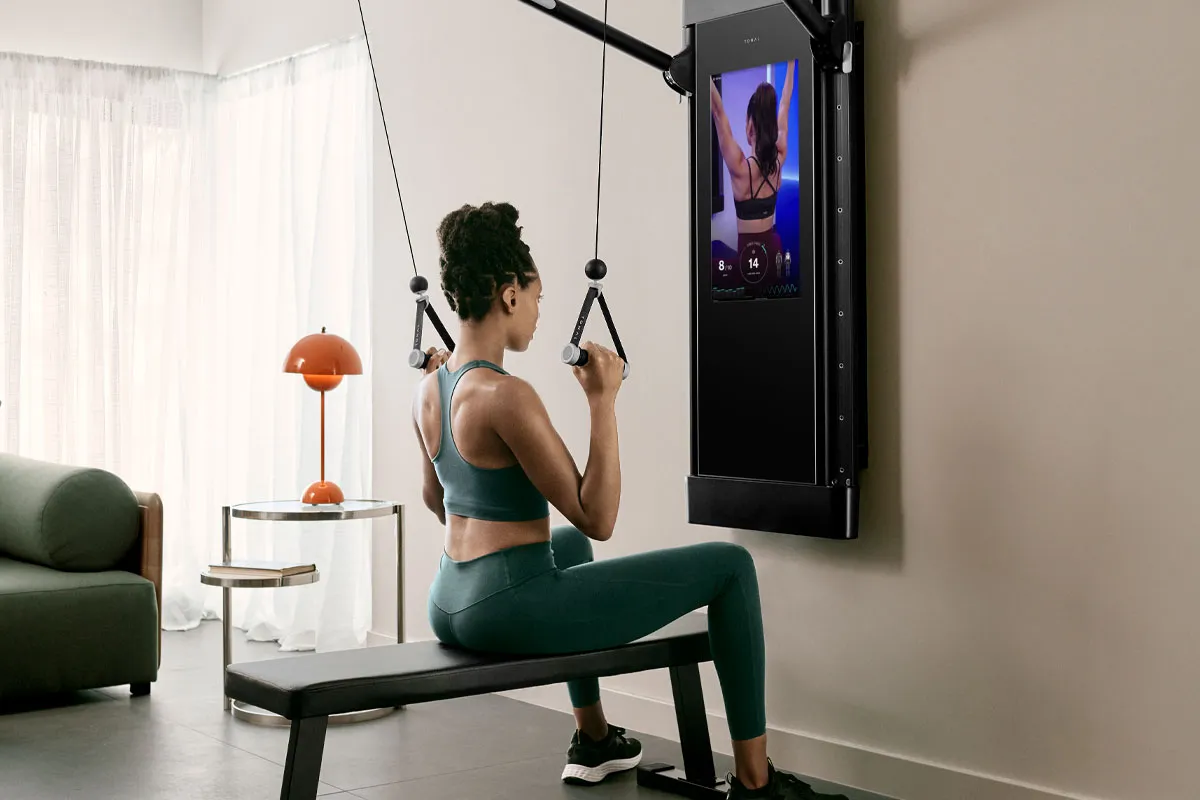Sitting too much lengthens and weakens your glutes. These exercises will combat that.
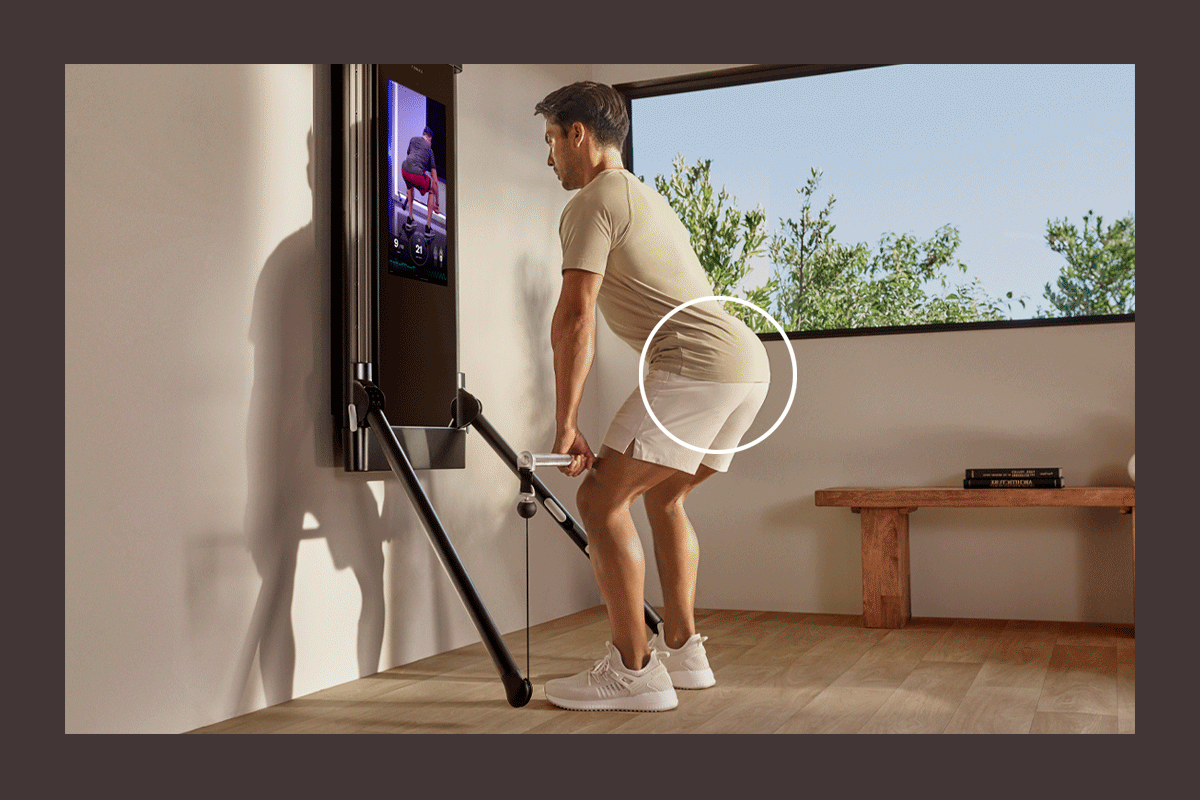
For the amount of time you spend sitting on your butt, glute exercises should be at the center of any strength training workout you do.
“Strong glutes are going to make you a better athlete in general,” says Jenna Moore, a certified strength and conditioning coach and Programming Specialist at Tonal.
Plus, the stronger the glutes, the healthier (in general) people tend to be, adds Josh Clay, a certified strength and conditioning specialist and Fitness Programming Specialist at Tonal.
Your butt is actually made up of three different muscles: the gluteus maximus, gluteus medius, and gluteus minimus. (Fun fact: The glute max is the largest muscle in the human body.) This muscle group also works directly with the hamstrings, calves, and back—your posterior chain. So strengthening your glutes isn’t just an aesthetic endeavor; strong glutes are crucial for proper pelvic alignment, strong hip extension, and improved hip mobility. And that “can help you deal with some of the day-to-day chronic aches and pains you may feel,” says Moore.
Ready to get off your butt and tap into some serious power? Try these at-home glute exercises you can do with and without Tonal.
5 At-Home Glute Exercises You Can Do Without Weights
You can start doing highly effective at-home glute exercises with body weight alone. Turn this list from Tonal’s fitness experts into a mini home glute workout by performing each move for 30 seconds, then repeating. Start with just two or three rounds, and as you get stronger, see if you can add in more reps in the same amount of time or increase the number of sets.
1. Squat with Plyometrics

The Benefit: “Squats are an incredible way to train the glutes, and adding a jump or calf raise will fire up your fast-twitch muscle fibers—which are responsible for explosive movement,” says Moore. Plyometric exercises like this require a quick eccentric contraction (during which the muscle is lengthened), followed immediately by a concentric contraction, (during which the muscle rapidly shortens), which increases your ability to generate force.
The How: Begin with your feet shoulder-width apart. Bend your knees and send your hips back to descend to a full squat position, like you’re sitting into a chair with your arms straight down toward the floor. Press through your heels to push the floor away, jumping up while bringing the arms overhead. (You can modify this move by squatting to an explosive calf raise so your feet don’t leave the ground.) Land gently in a squat position and immediately repeat.
2. Lateral Lunge

The Benefit: “Your glute medius, which tends to get not as much love and attention, fires up the most when you move side to side,” says Moore. “Moving multi-directionally is so important because your body needs to be able to adjust and catch you if you trip off a curb or over your dog. It’s key for resilience.”
The How: Stand with your feet hip-width apart. Take a big step to the side with your left leg, bending left knee, and send your hips back like you’re sitting into a chair while keeping the right leg straight. Press the floor away from you with the left leg and return to standing. Complete the reps on the left side then repeat on the right.
3. Gurtsy / Hip Airplanes
The Benefit: The gurtsy really engages the glute max through the single-leg nature of the move. But “the reach across and away from the body’s midline requires movement at the pelvis, which also recruits the glute med,” says Clay. And by keeping the leg in the air and lifting your knee towards your chest at the end of the move, you’re making it a balance challenge as well.
The How: Start in a standing position. Reach one leg back to lower down, dropping the knee toward the mat. Just before the knee reaches the mat, cross it behind the planted foot, just outside the ankle. Press the floor away from you with the glute of the front leg to power up, bringing your knee towards your chest before repeating on the same side. Check out this video for reference.
4. Lateral Bridge with Abduction
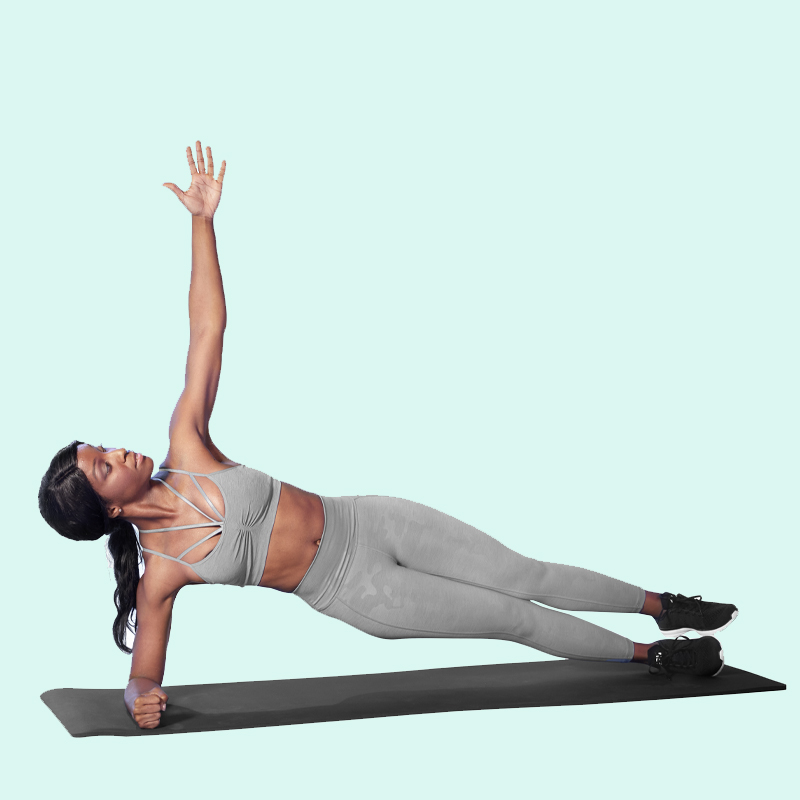
The Benefit: “This exercise requires a high degree of glute medius isometric strength to help provide stability at the pelvis,” says Clay. In fact, one study found that the side plank abduction produced the most activity at the glute med relative to other common exercises. “Most of the action here actually occurs in the bottom leg, where the glute med of the bottom leg must work isometrically to drive the foot into the ground and keep the hips up,” explains Clay.
The How: Lie on your side and prop yourself up on your bottom elbow and the side of your foot. Put your top arm on your hip. Lift your hips to form a straight line between your ankles, hips, and shoulders. Lift up your top leg while it is fully extended. Lower your leg to the starting position and repeat. Turn to the other side and repeat the exercise with the other leg.
5. Bulgarian Split Squat
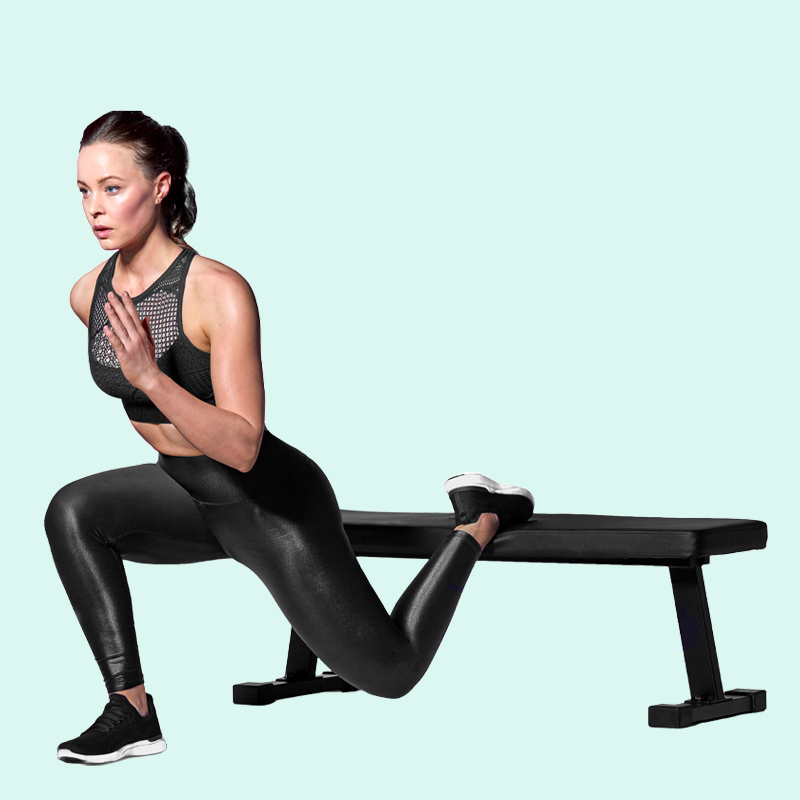
The Benefit: “Elevating that rear leg is really important to balance, especially when you’re talking about glutes,” says Moore. “We’re not meant to be perfectly symmetrical, but it’s important to maintain muscular balance to the best of our abilities, and unilateral exercises like this help keep your dominant side from taking over and isolate the muscles on each side.”
The How: Reach your left leg back, placing the top of the foot on a bench and stand tall. Keeping your right heel down like it’s glued to the floor, bend your right knee to drop your hips down until your right thigh is parallel with the floor. Press the floor away from you to stand and repeat. Complete the reps, then repeat on the left leg.
Take Your Home Glute Workout to the Next Level With Tonal
Adding load—as in, using Tonal’s digital weight—can help facilitate bigger (and faster) gains than using only body weight. “Intensity drives adaptation,” says Clay. Once your body has become accustomed to its own body weight, it’s time to up the ante.
1. Barbell Sumo Deadlift
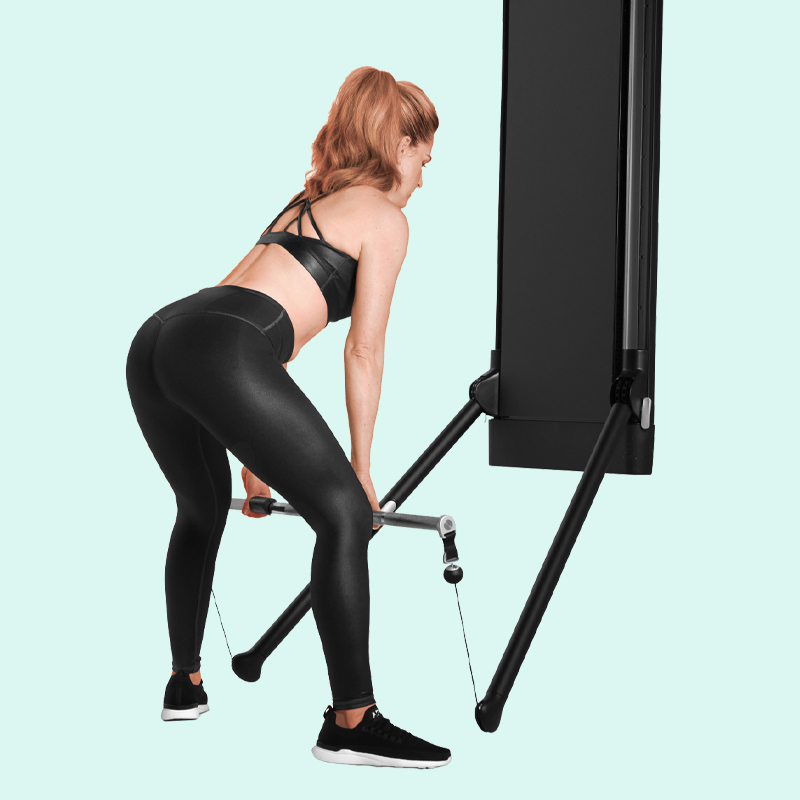
The Benefit: A deadlift targets all the muscles on your backside, but “you get a little more into the glutes in the Sumo deadlift, because you have some external rotation and the hips and your toes are slightly turned out,” says Moore. This is a big compound move, and you can lift a lot of weight in it—leading to more gains.
The How: Grab the bar and hold it in front of your thighs with your arms straight. Stand with feet wider than shoulder-width apart and toes pointed slightly out. Hinge at the hips and bend your knees as you lower the bar between your legs while keeping the core engaged. With a straight back, stand by pressing the floor away from you. Repeat.
2. Barbell Hip Thrust
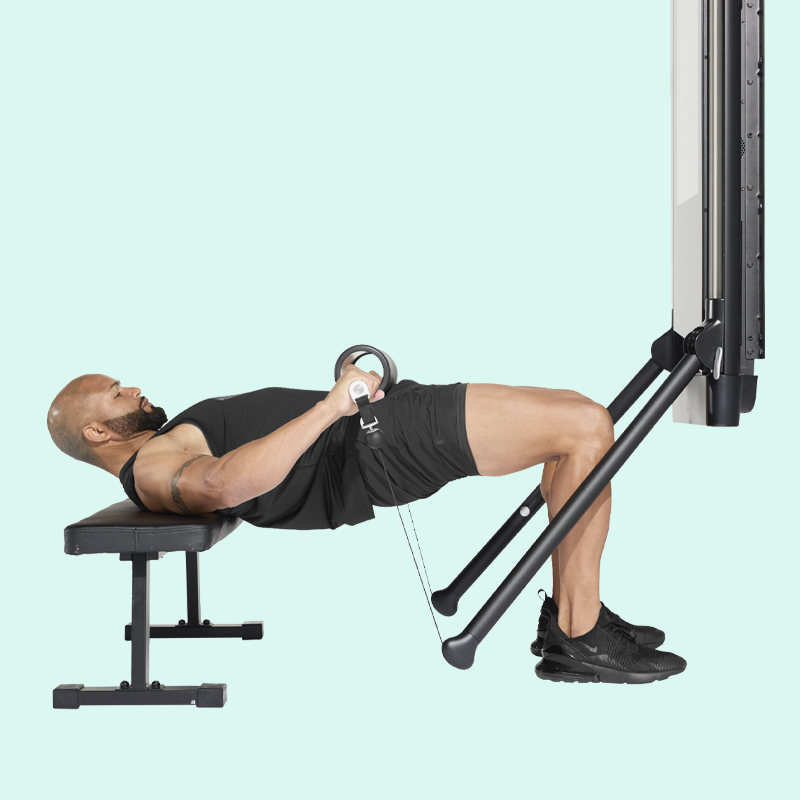
The Benefit: While a deadlift targets your whole posterior chain, the barbell hip thrust is a more isolated glute exercise. “The hip thrust is such a good movement because it trains the glutes in a shortened position,” says Clay. “When the hips are extended, that’s the point where the glutes have the most leverage—where they can generate the most amount of force.”
The How: Place your shoulders and upper back on the bench as you position the bar on your hips. Bring your ankles under your knees hip-width apart with hips just above the floor. Press the floor away with your feet, squeezing the glutes to lift the hips toward the ceiling. Lower your hips back down toward the floor. Repeat.
3. Single-Leg Romanian Deadlift

The Benefit: “The great thing about the RDL is now we’re hitting the glutes in a lengthening position,” says Clay. “The lengthened position is best for muscle growth because it maximizes torque at a joint. When loads are heavy enough and we train near failure, we can maximize mechanical tension—the primary driver of hypertrophy.”
The How: Stand facing the Tonal and grab the handles with each hand. With a micro-bend in your right knee, engage your core and hinge at the hips as your left leg lifts up behind you, keeping your back flat. Imagine your hips are like headlights and keep them both pointed directly at the floor. Use the right glute to power the torso back up and repeat. Complete the reps, then repeat on the other leg.
4. Resisted Step-Up
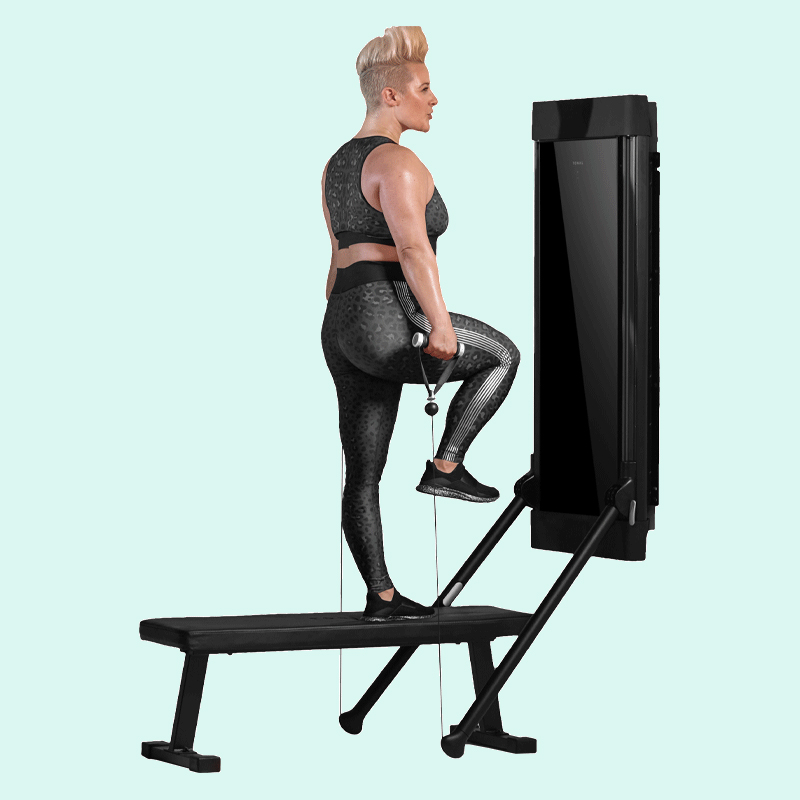
The Benefit: So simple, yet so effective. In addition to boosting glute strength, “these have the added benefit of enhancing stabilization and balance, due to the unilateral motion,” says Moore. “Step-ups also train explosive strength, which can help athletes in other movements such as sprinting and vertical jumps.”
The How: Grab the handles and place your feet hip-width apart, shoelaces lined up with the end of Tonal’s arms. With your arms down by your sides and a micro-bend in your knees, engage your core and send your hips back. Keeping your arms and back straight, hinge at the hips, and lower the handles down as far as you can. Thrust your hips forward to return to standing. Once at the top, keep your chest proud and repeat.
Try These Glute-Strengthening Tonal Workouts and Programs
You can program the exercises above into a Custom Workout on Tonal through the mobile app, or check out one of the coach-led, glute-focused workouts below.
Quick Fit: Glute Pump – Coach Natalie Carey
In this short-but-effective, beginner-level workout, you’ll master two foundational movements—the lunge and hip-hinge pattern—that are essential for building strong glutes.
Quick Fit: Fast Blast Glutes – Coach Gabby Sansosti
It only takes 15 minutes to feel the burn in your glutes in this workout. The addition of core and cardio moves will keep your heart rate elevated the entire time.
Glute Burnout – Coach Paul Wright
In this advanced-level workout, you’ll challenge your glute strength while working on your hip stability.
Great Glutes – Coach Allison Tibbs
For even more structure, this four-week program includes four workouts per week that emphasize the glutes but also incorporate full-body moves for well-rounded strength.
Read More
